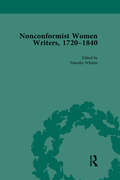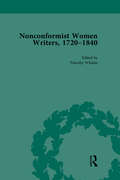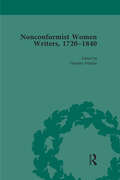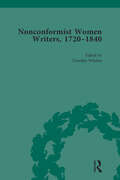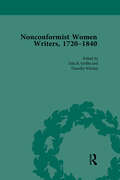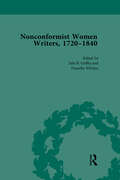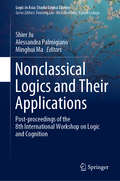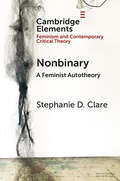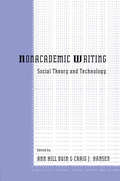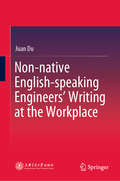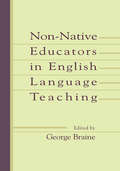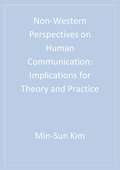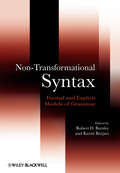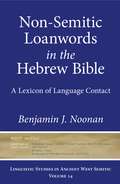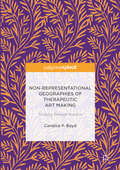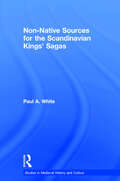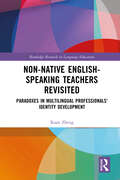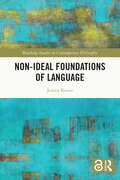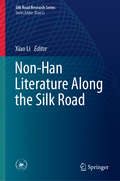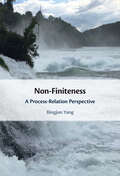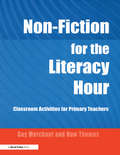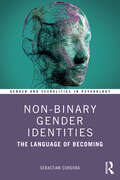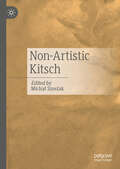- Table View
- List View
Nonconformist Women Writers, 1720-1840, Part II vol 7
by Timothy WhelanThese volumes will present, in some cases for the first time, the lives and works of a coterie of Nonconformist women writers from the West Country.
Nonconformist Women Writers, 1720-1840, Part II vol 6
by Timothy WhelanThese volumes will present, in some cases for the first time, the lives and works of a coterie of Nonconformist women writers from the West Country.
Nonconformist Women Writers, 1720-1840, Part II vol 5
by Timothy WhelanThese volumes will present, in some cases for the first time, the lives and works of a coterie of Nonconformist women writers from the West Country.
Nonconformist Women Writers, 1720-1840, Part I Vol 4
by Timothy WhelanThese volumes will present, in some cases for the first time, the lives and works of a coterie of Nonconformist women writers from the West Country.
Nonconformist Women Writers, 1720-1840, Part I Vol 3
by Timothy WhelanThese volumes will present, in some cases for the first time, the lives and works of a coterie of Nonconformist women writers from the West Country.
Nonconformist Women Writers, 1720-1840, Part I Vol 2
by Timothy Whelan Julia B. GriffinThese volumes will present, in some cases for the first time, the lives and works of a coterie of Nonconformist women writers from the West Country.
Nonconformist Women Writers, 1720-1840, Part I Vol 1
by Timothy Whelan Julia B. GriffinThese volumes will present, in some cases for the first time, the lives and works of a coterie of Nonconformist women writers from the West Country.
Nonclassical Logics and Their Applications: Post-proceedings of the 8th International Workshop on Logic and Cognition (Logic in Asia: Studia Logica Library)
by Shier Ju Alessandra Palmigiano Minghui MaThis edited book focuses on non-classical logics and their applications, highlighting the rapid advances and the new perspectives that are emerging in this area. Non-classical logics are logical formalisms that violate or go beyond classical logic laws, and their specific features make them particularly suited to describing and reason about aspects of social interaction. The richness and diversity of non-classical logics mean that this area is a natural catalyst for ideas and insights from many different fields, from information theory to game theory and business science. This volume is the post-proceedings of the 8th International Conference on Logic and Cognition, held at Sun Yat-Sen University Institute of Logic and Cognition (ILC) in Guangzhou, China in December 2016. The conference series started in 2001, and is organized by the ILC, often in collaboration with various international research groups. This eighth installment was jointly organized by ILC and Alessandra Palmigiano's Applied Logic research group. The conference series aims to foster the development of effective logical tools to study social behavior from a philosophical, cognitive and formal perspective in order to challenge the field of logic in ways that open up new and exciting research directions.Chapter "The Category of Node-and-Choice Forms, with Subcategories for Choice-Sequence Forms and Choice-Set Forms" of this book is available open access under a CC BY 4.0 license at link.springer.com
Nonbinary: A Feminist Autotheory (Elements in Feminism and Contemporary Critical Theory)
by Stephanie D. ClareThis autotheoretical Element, written in the tense space between feminist and trans theory, argues that movement between 'woman' and 'nonbinary' is possible, affectively and politically. In fact, a nonbinary structure of feeling has been central in the history of feminist thought, such as in Simone de Beauvoir's The Second Sex (1949). This structure of feeling is not antifeminist but indexical of a desire for a form of embodiment and relationality beyond binary sex and gender. Finally, the Element provides a partial defense of nonbinary gender identity by tracing the development of the term in online spaces of the early 2000s. While it might be tempting to read its development as symptomatic of the forms of selfhood reproduced in (neo)liberal, racialized platform capitalism, this reading is too simplistic because it misses how the term emerged within communities of care.
Nonacademic Writing: Social Theory and Technology
by Ann Hill DuinIn this volume, methodological, cultural, technological, and political boundaries felt by writers are analyzed, translated, and challenged in a way that will appeal to researchers, theorists, graduate students, instructors, and managerial audiences. Instead of extracting rules from previous research, the contributors, working from multidisciplinary perspectives, describe and analyze the social and technological contexts surrounding nonacademic writing. Their essays present a formative rather than summative outlook toward future research on nonacademic writing. Collectively, these chapters articulate a unique perspective toward nonacademic writing that considers: * The centrality of emerging communications technologies in nonacademic writing research and the need for a socio-technological perspective. New technologies reshape the concept of text and significantly impact the writing process and written products in nonacademic settings. * The relationship between the academy and the workplace. A number of chapters challenge us -- sometimes from opposing perspectives -- to scrutinize our role as writing educators in preparing students for the workplace. Should we support the interests of corporate employers, or should we resist those interests? Should we enculturate students in workplace writing practices by placing them in these environments, or should we examine the tacit knowledge gained by workplace professionals and deliver this via classroom instruction? * New theory, new research agendas. Contributors from diverse fields offer new theoretical lenses or use established lenses in innovative ways, expanding the agenda for nonacademic writing research. This volume represents the vision the social landscape demands for research and pedagogy in nonacademic writing.
Non-native English-speaking Engineers’ Writing at the Workplace
by Juan DuBased on 55 semi-structured in-depth interviews, this book investigates 15 high-tech engineering co-op professionals’ writing experience in the workplace. It shows how the digital age has had a marked impact on the engineers’ methods of communication at work, and how on-the -job writing has affected engineers’ technical competence, shaped their professional identities, challenged their views on Chinese and English writing, and hindered their success in the workplace. The book identifies three aspects of writing practice: engineers’ linguistic and literacy challenges, the reasons behind these challenges, and coping strategies, which suggest that engineers are underprepared and lack necessary support in the workplace. Lastly, the study shows that engineers need to engage in technical literacy through on-the-job writing so that they can fully deal with workplace discourse and socialize with diverse professional groups.Since the sample group interviewed in this book is engineers who studied at universities in the United States and have a foot in the world of school and work as well as knowledge of both Eastern and Western cultures, the book appeals to teachers, students, engineers and scientists who are interested in scientific and technological writing. It is also valuable for educators who prepare scientists, engineers, and technical communicators for professional roles, as well as for communication practitioners who work with engineers.
Non-native Educators in English Language Teaching
by George BraineThe place of native and non-native speakers in the role of English teachers has probably been an issue ever since English was taught internationally. Although ESL and EFL literature is awash, in fact dependent upon, the scrutiny of non-native learners, interest in non-native academics and teachers is fairly new. Until recently, the voices of non-native speakers articulating their own concerns have been even rarer. This book is a response to this notable vacuum in the ELT literature, providing a forum for language educators from diverse geographical origins and language backgrounds. In addition to presenting autobiographical narratives, these authors argue sociopolitical issues and discuss implications for teacher education, all relating to the theme of non-native educators in ETL. All of the authors are non-native speakers of English. Some are long established professionals, whereas others are more recent initiates to the field. All but one received part of the higher education in North America, and all except two of the chapters are at least partially contextualized in North America. Particularly relevant for non-native speakers who aspire to enter the profession, graduate students in TESOL programs, and teacher educators, the unique nature of this book's contributors and its contents will interest researchers and professionals in applied linguistics generally and in ELT, and all those who are concerned with the role of non-native speakers in English-language teaching.
Non-Western Perspectives on Human Communication: Implications for Theory and Practice
by Dr Min-Sun KimWhat it means to be a self - and a self communicating and being in a particular culture - are key issues interwoven throughout Min-Sun Kim's impressive text, Non-Western Perspectives on Human Communication. Going beyond cultural descriptions or instructions on adapting to specific cultures, the author interrogates the very core assumptions underlying the study of human communication and challenges longstanding individualistic, Western models on which much intercultural research is based. Kim proposes a non-western way of conceptualizing identity, or the "self" - the cornerstone of cultural research -- illuminating how traditional western and non-western views can be blended into a broader, more realistic understanding of cultures and communication. Grounding her work in a thorough knowledge of the literature, she challenges students and researchers alike to reexamine their approach to intercultural study.
Non-Transformational Syntax: Formal and Explicit Models of Grammar
by Kersti Börjars Robert D. BorsleyThis authoritative introduction explores the four main non-transformational syntactic frameworks: Head-driven Phrase Structure Grammar, Lexical-Functional Grammar, Categorial Grammar, and Simpler Syntax. It also considers a range of issues that arise in connection with these approaches, including questions about processing and acquisition. An authoritative introduction to the main alternatives to transformational grammar Includes introductions to three long-established non-transformational syntactic frameworks: Head-driven Phrase Structure Grammar, Lexical-Functional Grammar, and Categorial Grammar, along with the recently developed Simpler Syntax Brings together linguists who have developed and shaped these theories to illustrate the central properties of these frameworks and how they handle some of the main phenomena of syntax Discusses a range of issues that arise in connection with non-transformational approaches, including processing and acquisition
Non-Semitic Loanwords in the Hebrew Bible: A Lexicon of Language Contact (Linguistic Studies in Ancient West Semitic)
by Benjamin J. NoonanAncient Palestine served as a land bridge between the continents of Asia, Africa, and Europe, and as a result, the ancient Israelites frequently interacted with speakers of non-Semitic languages, including Egyptian, Greek, Hittite and Luwian, Hurrian, Old Indic, and Old Iranian. This linguistic contact led the ancient Israelites to adopt non-Semitic words, many of which appear in the Hebrew Bible. Benjamin J. Noonan explores this process in Non-Semitic Loanwords in the Hebrew Bible, which presents a comprehensive, up-to-date, and linguistically informed analysis of the Hebrew Bible’s non-Semitic terminology.In this volume, Noonan identifies all the Hebrew Bible’s foreign loanwords and presents them in the form of an annotated lexicon. An appendix to the book analyzes words commonly proposed to be non-Semitic that are, in fact, Semitic, along with the reason for considering them as such. Noonan’s study enriches our understanding of the lexical semantics of the Hebrew Bible’s non-Semitic terminology, which leads to better translation and exegesis of the biblical text. It also enhances our linguistic understanding of the ancient world, in that the linguistic features it discusses provide significant insight into the phonology, orthography, and morphology of the languages of the ancient Near East. Finally, by tying together linguistic evidence with textual and archaeological data, this work extends our picture of ancient Israel’s interactions with non-Semitic peoples.A valuable resource for biblical scholars, historians, archaeologists, and others interested in linguistic and cultural contact between the ancient Israelites and non-Semitic peoples, this book provides significant insight into foreign contact in ancient Israel.
Non-Semitic Loanwords in the Hebrew Bible: A Lexicon of Language Contact (Linguistic Studies in Ancient West Semitic #14)
by Benjamin J. NoonanAncient Palestine served as a land bridge between the continents of Asia, Africa, and Europe, and as a result, the ancient Israelites frequently interacted with speakers of non-Semitic languages, including Egyptian, Greek, Hittite and Luwian, Hurrian, Old Indic, and Old Iranian. This linguistic contact led the ancient Israelites to adopt non-Semitic words, many of which appear in the Hebrew Bible. Benjamin J. Noonan explores this process in Non-Semitic Loanwords in the Hebrew Bible, which presents a comprehensive, up-to-date, and linguistically informed analysis of the Hebrew Bible’s non-Semitic terminology.In this volume, Noonan identifies all the Hebrew Bible’s foreign loanwords and presents them in the form of an annotated lexicon. An appendix to the book analyzes words commonly proposed to be non-Semitic that are, in fact, Semitic, along with the reason for considering them as such. Noonan’s study enriches our understanding of the lexical semantics of the Hebrew Bible’s non-Semitic terminology, which leads to better translation and exegesis of the biblical text. It also enhances our linguistic understanding of the ancient world, in that the linguistic features it discusses provide significant insight into the phonology, orthography, and morphology of the languages of the ancient Near East. Finally, by tying together linguistic evidence with textual and archaeological data, this work extends our picture of ancient Israel’s interactions with non-Semitic peoples.A valuable resource for biblical scholars, historians, archaeologists, and others interested in linguistic and cultural contact between the ancient Israelites and non-Semitic peoples, this book provides significant insight into foreign contact in ancient Israel.
Non-Representational Geographies of Therapeutic Art Making
by Candice P. BoydUtilising non-representational theories and practice-led research methods, this book serves to reclaim therapeutics as ecological, spatial and material. It examines the sites and performances of a wide range of therapeutic art practices, including painting and drawing, dance movement therapy, fibre art, subterranean graffiti practice, and poetic permaculture. In doing so it provides an important assessment of the role and status of therapy in contemporary life. A highly interdisciplinary text, Boyd’s research is informed by a thorough reading of post-structural theory including contemporary feminism, Guattari’s ethico-aesthetic paradigm, Whitehead’s process-oriented ontology, and Deleuze’s writing on sense and the event. This innovative study will prove essential for scholars and practitioners of cultural geography, socially-engaged art, therapeutic studies, and occupational therapy.
Non-Native Sources for the Scandinavian Kings' Sagas (Studies In Medieval History And Culture Ser. #34)
by Paul A. WhiteTraditional scholarship on the kings' sagas has tended to focus on the textual histories and interrelationships between the various twelfth- and thirteenth-century Scandinavian manuscripts. Thus previous scholars have striven to ascertain chronology, dating, and potential literary borrowings between the various native medieval manuscripts without considering the possibility of foreign textual influences on native literary traditions. Non-Native Sources for the Scandinavian Kings' Sagas prompts scholars to look beyond the borders of medieval Scandinavia in the attempt to account for seemingly inexplicable literary motifs and historical accounts.
Non-Native English-Speaking Teachers Revisited: Paradoxes in Multilingual Professionals' Identity Development (Routledge Research in Language Education)
by Xuan ZhengDrawing on ethnographical evidence, this book examines the complexity of the controversial construct “Non-Native English-Speaking Teacher” (NNEST) and the newly proposed “translingual/translanguaging teacher” in re-scripting their identities.Zheng examines the process of international graduate students’ learning to become composition teachers and English professionals in the United States. The book addresses the danger of either constructing fixed boundaries or dissolving them and helps readers to understand the duality of fixity and fluidity in identity development. Zheng advocates for open dialogue between different ideologies in approaching language diversity in schools with the same aim of social justice.This volume will attract academic readers from a range of disciplines and in different contexts: trainers of international teaching assistants, composition/second language writing scholars, and present or future professionals in TESOL/second/foreign language teaching.
Non-Ideal Foundations of Language (Routledge Studies in Contemporary Philosophy)
by Jessica KeiserThis book argues that the major traditions in the philosophy of language have mistakenly focused on highly idealized linguistic contexts. Instead, it presents a non-ideal foundational theory of language that contends that the essential function of language is to direct attention for the purpose of achieving diverse social and political goals. Philosophers of language have focused primarily on highly idealized linguistic contexts in which cooperative agents are working toward the shared goal of gaining information about the world. This approach abstracts away from important issues like power, ideology, social position, and diversity of goals which are crucial to explaining linguistic phenomena both at the semantic and pragmatic levels. This book begins by examining the work of some of the pioneers of this tradition—primarily David Lewis, Paul Grice, and Robert Stalnaker. The author shows that various problems have their source in idealizations made at the foundational level of linguistic theory and proposes to rebuild from the ground-up. She presents a non-ideal foundational theory of language which retains the major insights of traditional frameworks while rejecting the social idealizations that guide them. Then, she explores the social and political applications of her account to issues such as dog whistling, propaganda, racist speech, silencing, and manipulation. Non-Ideal Foundations of Language will appeal to researchers and advanced students in philosophy of language who are interested in the social and political applications of language, as well as traditional metasemantic theory.
Non-Han Literature Along the Silk Road (Silk Road Research Series)
by Xiao LiThis volume includes outstanding scientific articles on documents written in ancient languages such as Tocharian, Sogdian, Khotanese, and Old Uyghur. Its chief aims are to contribute to the present state of research by adding essential findings on newly discovered historical documents; to present a multi-dimensional investigation of diverse aspects including the history, religion, art, literature, and social life along the Silk Road; and to outline potential future research directions for non-Han literature studies and inspire research into other aspects, such as economics and comparative studies.
Non-Finiteness: A Process-Relation Perspective
by Bingjun Yang'Non-finiteness' is a phenomenon that occurs in most natural languages, whereby a verb is not inflected by grammatical tense, and does not possess the grammatical features of aspect, mood or voice. Various theories have been developed to explain their distribution and their role in clause structure, but many instances of non-finiteness remain unaccounted for. Taking a functional approach, this study proposes a 'process relation framework' to explain the more complex, previously unaccounted for, instances of non-finiteness in clause structure. It applies the framework comparatively to non-finiteness in English and Chinese, showing how it can be applied across typologically distinct languages. Drawing on corpus-based instances and observations, it introduces numerous thought-provoking cases, in which constructional (or combining) types and the predictability of non-finiteness co-occur. In terms of application, non-finiteness is decisive in categorising language types, and it is critical in processing natural languages, text segmentation and annotation in particular.
Non-Fiction for the Literacy Hour: Classroom Activities for Primary Teachers
by Huw Thomas Guy MerchantThis book offers practical guidance for teachers using the National Literacy Strategy at Key Stages 1 and 2, based on the six categories of non-fiction outlined in the Strategy. It gives an accessible introduction to the features of each of these text types. Many teachers now feel confident in working with fiction and poetry, whereas the non-fiction objectives have been more challenging. The book includes new subject knowledge, such as understanding the linguistic features of different text types, and the need to find authentic reading material; practical classroom examples; high-quality photocopiable texts and activity sheets; and detailed guidance on how to work with the material at text, sentence and word level. Each chapter consists of a description of the genre, a text example, a photocopiable double-page spread giving an annotated version of the text, details of the classroom resources for developing the ideas and activity sheets for each text. The book will appeal to all teachers and student teachers working at Key Stages 1 and 2, English and Literacy advisers in LEAs, and providers of initial and in-service training.
Non-Binary Gender Identities: The Language of Becoming (Gender and Sexualities in Psychology)
by Sebastian CordobaNon-Binary Gender Identities examines how non-binary people discover, adopt, and negotiate language in a variety of social settings, both offline and online. It considers how language, in the form of gender-neutral pronouns, names, and labels, is a central aspect of identity for many and has been the subject of much debate in recent years. Cordoba captures the psychological, social, and linguistic experiences of non-binary people by illustrating the multiple, complex, and evolving ways in which non-binary people use language to express their gender identities, bodies, authenticity, and navigate social interactions – especially those where their identities are not affirmed. These findings shed light on the gender and linguistic becomings of non-binary people, a pioneering theoretical framework developed in the book, which reflects the dynamic realities of language, subjectivities, and the materiality of the body. Informed by these findings, the text offers recommendations for policy makers and practitioners, designed to facilitate gender-related communication and decrease language-related distress on non-binary people, as well as the general population. This important book advances our understanding of non-binary gender identities by employing innovative methodologies – including corpus-based research and network visualisation – furthering and developing theory, and yielding original insights. It is essential reading for students and academics in social psychology and gender studies, as well as anyone interested in furthering their understanding of non-binary gender identities.
Non-Artistic Kitsch
by Michał SzostakThe book aims to provide a contemporary individual with an extensive but focused set of examples of kitsch in non-artistic spheres to create theoretical and practical backgrounds for conscious recognition of kitsch in fields like psychology, education, politics, law, religion, terrorism, television, or journalism. Two perspectives are underlined: 1) the consciousness of the presence and role of kitsch experience within the philosophy of living and 2) the management of kitsch experience within the philosophy of living (kitsch as a means for achieving goals). Due to the diverse topics covered by particular chapters, no unified methodology is applied in the whole volume. However, due to the kitsch’s complex and metaphysical character, the only fundament is using the “kitsch experience theory” (Szostak and Sułkowski, 2020) to narrate the volume coherently. The authors apply a qualitative methodological approach, extensively using case studies, comparative analyses, and ethnographic focus.
